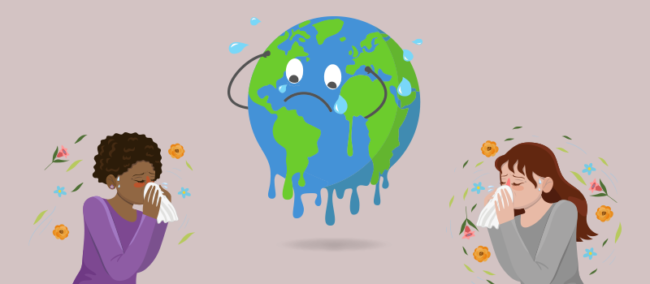
Climate change is an increasingly pressing issue, and its effects of it’s are being felt all over the world. One of climate change’s most common impacts is the increase in pollen allergies. Climate change affects plants, including increasing pollen production, altering pollen composition, and changing seasonality. Pollen allergies are becoming more widespread and more severe and occurring earlier in the year.
Pollen Production
Climate change has caused temperatures to increase, resulting in higher levels of carbon dioxide in the atmosphere. This has caused plants to grow more quickly and produce more pollen. This increase in pollen production can be seen in a variety of plants, including ragweed and trees. Higher levels of pollen can result in more severe allergies for those with pollen allergies.
Pollen Composition
Climate change can also affect the composition of pollen. Warmer temperatures can cause pollen grains to become larger, making them more likely to trigger allergic reactions. Higher levels of carbon dioxide can also increase the number of proteins within pollen grains, which can cause more severe allergic reactions.
Pollen allergies are a common ailment affecting millions of people worldwide. This type of allergy is caused by inhaling pollen, which is a microscopic powder released by plants. Climate change continues to worsen, raising concerns that pollen allergies may become more widespread and severe.
This blog post will explore the potential connection between climate change and pollen allergies and discuss what can be done to reduce their impacts.
The most significant factor connecting climate change and pollen allergies is the fact that rising temperatures can cause plants to produce more pollen. Since warmer temperatures allow plants to grow and reproduce more quickly, they can release more pollen into the air. This increased pollen production can lead to more exposure for those with allergies. Additionally, changes in precipitation patterns due to climate change can also affect the amount of pollen in the air. For example, if temperatures increase and there is less rain to wash away the pollen, people will be exposed to higher pollen concentrations.
There is also evidence that climate change can affect the composition of the pollen itself. Certain plants may become more or less common in a given area as the environment changes. This can lead to an increase in certain allergenic pollen types, such as ragweed, which is especially common in the United States. Additionally, higher temperatures can cause certain plants to produce larger and more allergenic pollen grains.
Unfortunately, the impact of climate change on pollen allergies can be challenging to predict. In some parts of the world, such as the United States, researchers have observed a rise in the number of days with high pollen count. However, in other areas, the effects of climate change may be clarified. Furthermore, the impact of climate change on pollen allergies may vary from region to region, as different plants may be more or less sensitive to changing temperatures.
Despite the uncertainties, steps can still be taken to reduce the impact of pollen allergies. For example, people can reduce their exposure to pollen by staying indoors when pollen counts are high. Additionally, people can take steps to reduce their own sensitivity to pollen, such as avoiding certain foods or taking medication. Finally, people can help reduce the effects of climate change by reducing their carbon emissions.
About Ambee’s Environmental Data
Ambee provides global pollen data with a demonstrably high degree of accuracy and street-level granularity. Ambee’s go-to pollen index is NAB-standard, and the data is generated through a multi-modal approach combining data from proprietary on-ground sensors, satellites, and multiple open sources.
Ambee’s pollen data enables anyone, anywhere in the world, to understand their hyperlocal environment in real time. The datasets provided by Ambee are used to power decisions across continents, from startups to Fortune 500 companies. Companies can create valuable campaigns and solutions that help their customers avoid seasonal allergies using pollen forecast data, real-time pollen count data, and historical insights.
Climate change can have a significant impact on pollen allergies. As temperatures rise, plants may produce more pollen and change precipitation patterns. Weather also affects pollen allergies. Using Ambee’s pollen API, weather API and, allergy forecast becomes easier.
Stay Connect With Our Health Blog & Write for us health
